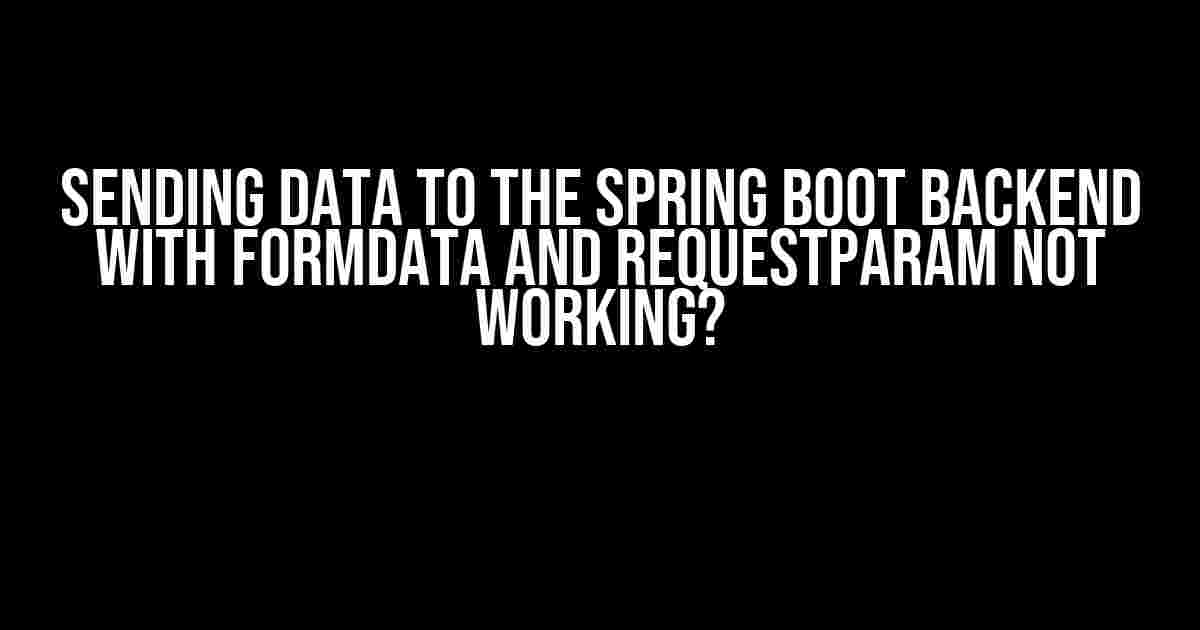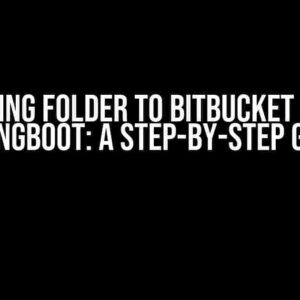Are you struggling to send data from your frontend to your Spring Boot backend using FormData and RequestParam? Well, you’re not alone! Many developers have been in your shoes, and I’m here to guide you through the solutions to get you back on track.
Understanding the Problem
When working with Spring Boot, it’s common to encounter issues when sending data from the frontend to the backend using FormData and RequestParam. This can be frustrating, especially when you’ve followed all the tutorials and documentation to the letter. But don’t worry, we’re about to dive into the possible reasons behind this issue and explore the solutions.
Why isn’t it working?
There are several reasons why sending data with FormData and RequestParam might not be working as expected. Here are some common culprits:
- Incorrect configuration of the backend: Check that your Spring Boot application is correctly configured to accept multipart/form-data requests.
- Inconsistent data types: Ensure that the data types of the frontend and backend match. For example, if you’re sending a file, make sure the backend is expecting a file.
- Missing or incorrect annotations: Verify that you’ve added the necessary annotations to your controller methods, such as @RequestParam or @RequestBody.
- Frontend issues: Check that your frontend code is correctly sending the data using FormData and RequestParam.
Solutions to Get You Back on Track
Now that we’ve identified the possible reasons behind the issue, let’s dive into the solutions.
Configuring the Backend
To accept multipart/form-data requests, you need to add the following configuration to your Spring Boot application:
@Configuration
public class WebConfig extends WebMvcConfigurerAdapter {
@Override
public void configureHttpMessageConverters(List<HttpMessageConverter<?>> converters) {
converters.add(new ByteArrayHttpMessageConverter());
converters.add(new StringHttpMessageConverter(Charset.forName("UTF-8")));
converters.add(new FormHttpMessageConverter());
}
@Override
public void addResourceHandlers(ResourceHandlerRegistry registry) {
registry.addResourceHandler("/upload/**")
.addResourceLocations("file:/upload-temp/");
}
}This configuration enables your Spring Boot application to accept multipart/form-data requests and converts the incoming data to the desired format.
Using @RequestParam Correctly
To use @RequestParam correctly, ensure that you’ve added the annotation to the correct method parameter:
@PostMapping("/upload")
public String handleFileUpload(@RequestParam("file") MultipartFile file) {
// Process the file
return "redirect:/uploadStatus";
}In this example, the @RequestParam annotation is used to inject the uploaded file into the handleFileUpload method.
Sending Data from the Frontend
To send data from the frontend using FormData and RequestParam, use the following code:
// Create a FormData object
var formData = new FormData();
// Add data to the FormData object
formData.append("file", fileInput.files[0]);
// Send the data to the backend using XMLHttpRequest
var xhr = new XMLHttpRequest();
xhr.open("POST", "/upload", true);
xhr.send(formData);In this example, we create a FormData object and add the uploaded file to it. We then send the data to the backend using XMLHttpRequest.
Troubleshooting Tips
If you’re still having issues, here are some troubleshooting tips to help you identify the problem:
- Check the network requests: Use the browser’s developer tools to inspect the network requests and verify that the data is being sent correctly.
- Verify the backend logs: Check the backend logs to ensure that the data is being received and processed correctly.
- Use a debugging tool: Use a debugging tool like Postman or cURL to send requests to the backend and verify that the data is being received correctly.
- Check the frontend code: Review the frontend code to ensure that the data is being sent correctly using FormData and RequestParam.
Conclusion
Sending data from the frontend to the Spring Boot backend using FormData and RequestParam can be a challenge, but by following the solutions and troubleshooting tips outlined in this article, you should be able to overcome the issues and get your application working as expected. Remember to configure the backend correctly, use @RequestParam correctly, and send data from the frontend using FormData and RequestParam.
| Summary of Solutions |
|---|
| Configure the backend to accept multipart/form-data requests |
| Use @RequestParam correctly to inject the uploaded file into the controller method |
| Send data from the frontend using FormData and RequestParam |
| Troubleshoot the issue using network requests, backend logs, debugging tools, and frontend code review |
By following these solutions and troubleshooting tips, you’ll be well on your way to resolving the issue and getting your application working as expected. Happy coding!
Frequently Asked Questions
Stuck with sending data to your Spring Boot backend with FormData and RequestParam? Don’t worry, we’ve got you covered! Here are some frequently asked questions and answers to help you troubleshoot and resolve the issue.
Why is my Spring Boot backend not receiving the data sent through FormData?
Make sure you have correctly configured the multipart/form-data content type in your HTTP request. Also, ensure that your Spring Boot controller method is annotated with @PostMapping, @RequestParam, and @RequestPart annotations. Additionally, verify that the FormData is correctly constructed and sent in the request body.
What is the correct way to send FormData with RequestParam in a Spring Boot application?
When sending FormData with RequestParam, make sure to use the @RequestParam annotation on the controller method parameter. Also, use the correct syntax for constructing the FormData object, such as new FormData() and append() method to add key-value pairs. Finally, send the FormData object in the request body with the correct content type.
How do I enable multipart/form-data in my Spring Boot application?
To enable multipart/form-data in your Spring Boot application, you need to configure the MultipartResolver in your application configuration file. You can do this by adding the following configuration: @Bean public MultipartResolver multipartResolver() { return new StandardServletMultipartResolver(); }
Why am I getting a “Current request is not a multipart request” error in my Spring Boot application?
This error usually occurs when the HTTP request does not have the correct multipart/form-data content type. Make sure to set the content type correctly in your HTTP request. Also, verify that your controller method is annotated with @RequestParam and @RequestPart annotations correctly.
Can I use RequestBody instead of RequestParam to send FormData to my Spring Boot backend?
Yes, you can use @RequestBody instead of @RequestParam to send FormData to your Spring Boot backend. However, make sure to use the correct annotation on the controller method parameter, and ensure that the FormData is correctly constructed and sent in the request body.


